Quick Introduction to Outlook Email Filters
Outlook mail filters, called Rules, are actions executed automatically based on set conditions. They can help you manage your emails by sorting, organizing, and prioritizing them as they arrive in your inbox, without the need for manual work.

Here are some examples of how you can filter emails in Outlook:
- Filter emails in Outlook to a specific folder: You can create a filter that automatically moves emails to a designated folder if they are from a particular sender or have a specific subject line.
- Organize emails in Outlook by category: You can use Outlook categories to color-code your emails so that you can quickly and easily find them later.
- Flag important messages: By creating a filter that automatically flags incoming emails that meet certain criteria, you can significantly decrease the likelihood of missing an important message.
- Auto-delete emails in Outlook: Sometimes, you may want to automatically delete emails in Outlook that are not important or downright malicious.
- Forward messages to a different address: Another useful filter option is to automatically forward certain emails to a different email address, which can be handy for backup purposes.
As you can see, knowing how to automatically filter emails in Outlook can be pretty useful. In the next sections, we will provide you with step-by-step guides featuring real-world examples of how to create and set up filters in Outlook and Clean Email, whose ease of use, advanced features, and support for mobile devices make it an excellent choice for those who want to take their email filtering to the next level.
How to Filter Outlook Emails: All Versions
In this section, we’ll guide you through the process of filtering messages in various Outlook applications.
On the Web
The Outlook app for the web is a free browser-based email client that offers many of the same features as the desktop version. Here is an example of how to set a filter that automatically assigns a color category to messages:
Step 1. Click on the gear icon in the top-right corner of the screen to open the Settings menu.

Step 2. In the Settings window, click on Mail in the left-hand menu and then click on Rules in the right-hand menu.
Step 3. To create a new rule, click on the Add new rule button in the Rules dialog box.
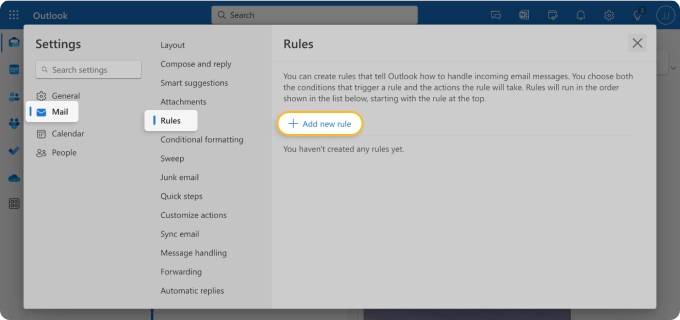

Step 4. Name the rule and then specify the conditions that the filter will use to determine which emails to act on. For our example, we'll create a filter that assigns a color category to emails from a specific sender. To do this, choose From in the first drop-down menu.
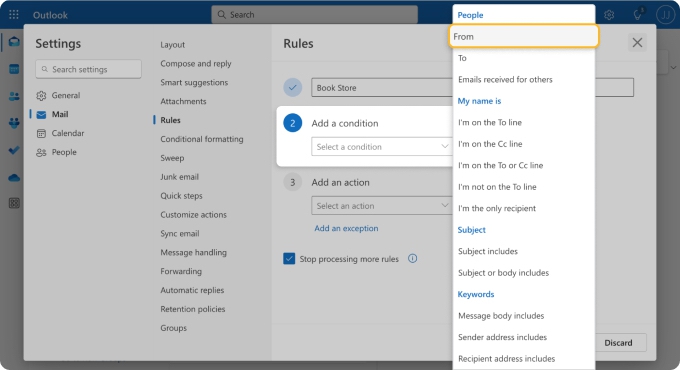
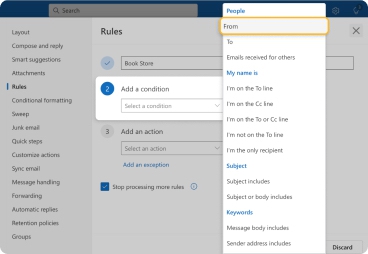
Step 5. Choose the action that the filter will take when it encounters an email that meets those conditions. For our example, we'll choose Categorize from the drop-down menu, and then choose the color category we want to assign to the email.
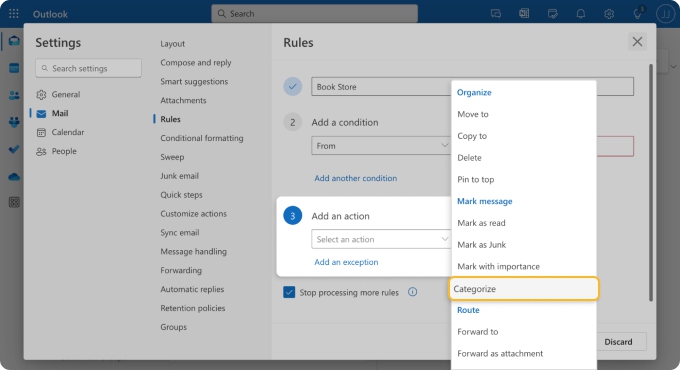
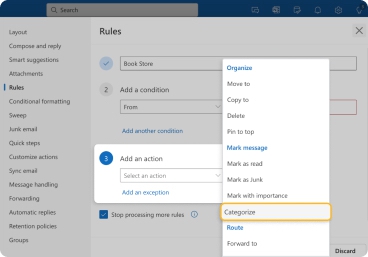
Step 6. Then, you can click the Save button.
From now on, the newly created filter will automatically organize and manage your messages.
On the Desktop
While the Outlook app for the web offers a simplified interface, Outlook for Mac and Windows are packed with useful features, and the ability to filter incoming emails is one of them. Here's how to set up a rule to automatically delete emails with a specific subject.
Step 1. Right-click on any message in your inbox or a specific Outlook folder and select Rules and then Manage Rules (Windows) or Edit Rules (Mac).


Step 2. Create a new rule. To do this, press the Add New Rule button on Windows or the New Rule button on Mac.

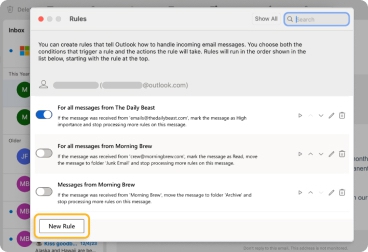
Step 3. Name the rule and then specify the conditions that the filter will use to determine which emails to act on. For our example, we'll choose Subject from the first drop-down menu and then enter the subject line we want to target in the second field.
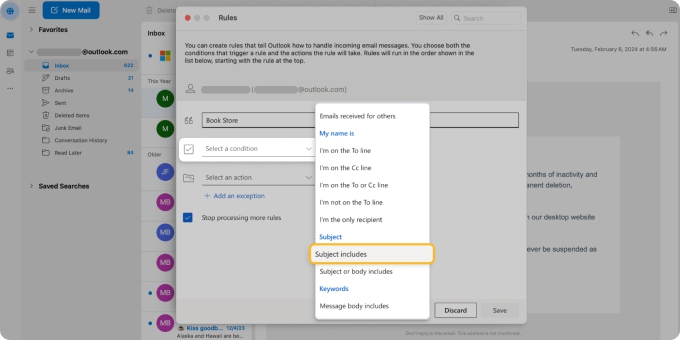

Step 4. Choose the action that the filter will take when it encounters an email that meets those conditions. For our example, we'll choose Delete from the drop-down menu.

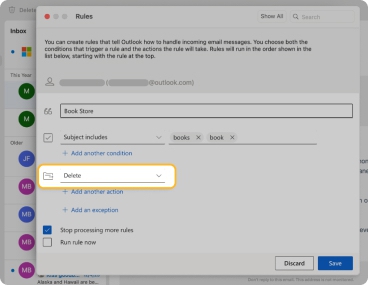
Step 5. Click on the Save button to save the filter.
Note that advanced email organization features in Outlook for Mac and Windows, including detailed filtering and rules, are mainly available for Microsoft-owned accounts like Outlook 365 or Outlook Live. Basic filtering can be applied to emails from other accounts such as Gmail or Yahoo configured in Outlook, but these features may not be as extensive.
If you would like to extend your email filtering capabilities beyond Outlook and apply similar rules to other email services you use, then you need a third-party email management tool like Clean Email.
On Mobile
Unfortunately, it is currently not possible to set up rules or filters in the Outlook mobile app for iOS and Android. However, there is a way to help improve automatic email filtering capabilities by moving important messages from the Other inbox to the Focused inbox.
Here's how to filter messages in Outlook for iOS and Android:
- Locate the message in your Other inbox tab and open it.
- Tap the three dots at the top of the screen.
- Tap Move to Focused Inbox.
- Tap Always Move, Move Once, or Cancel.


While this is not a true filtering solution, it can help ensure that important messages are not lost in the clutter of the Other inbox.
For those who need more advanced filtering capabilities on their mobile devices, there are third-party tools available. One such tool is Clean Email.
Clean Email: A Better Way to Filter Messages in Outlook
Clean Email is a third-party email management tool that offers a range of features to help you organize and manage your Outlook inbox, including advanced filtering capabilities, which are as easy to use as they are powerful. Here's how it works:
- Go to: https://app.clean.email and sign in with your email account.
- Find the specific message in your Inbox or use the search function.
- Select the message, hit the Create Rule button at the bottom, and then go to Move To under Apply Action (or select another action).
- Choose an existing folder or create a new one by typing its name and selecting Create.
- Optionally, apply this rule to existing messages by enabling the appropriate toggle. For more specific criteria, click Edit and add filters.
- Click Create Rule to set it for all future messages from this sender.
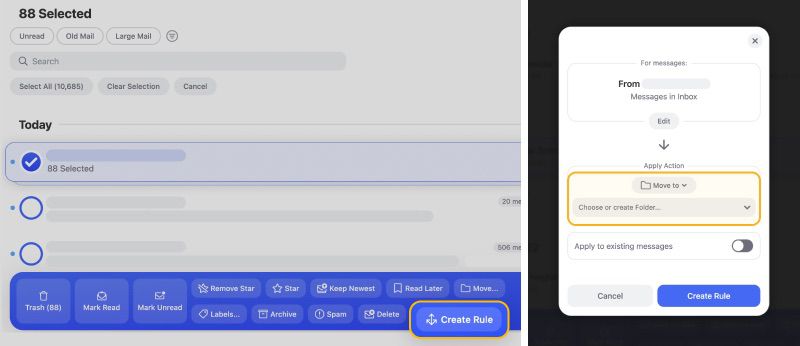
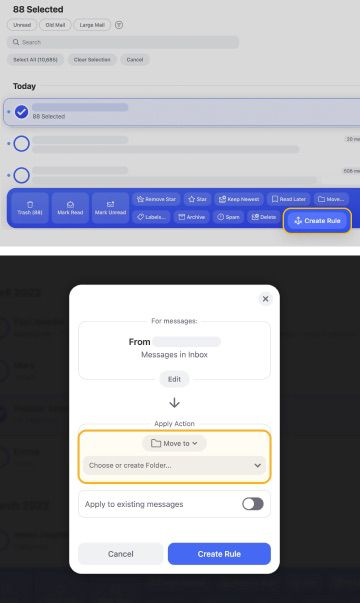
Next time you receive a message that matches your newly created Outlook rule, the rule will be automatically applied to it.
With Clean Email, you can create rules and filters to automatically sort and manage your emails, just like you can in the desktop version of Outlook. One of the key advantages of Clean Email is its multi-platform support. Whether you're using a web browser, mac, iOS, or Android app, the functionality remains consistent and fully featured across all platforms.
Here is how easy it is to set an Outlook rule from scratch in the Clean Email mobile app.
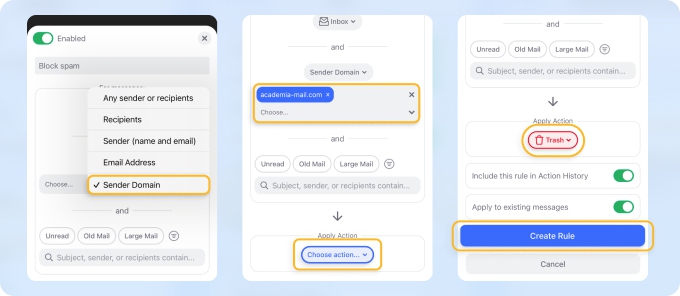
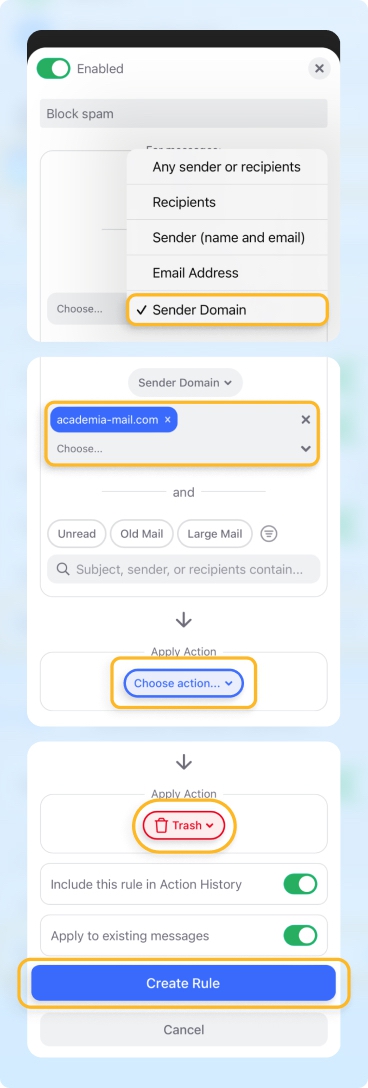
You can always check all your automated rules, pause them, and rerun when needed in the Auto Clean dashboard.
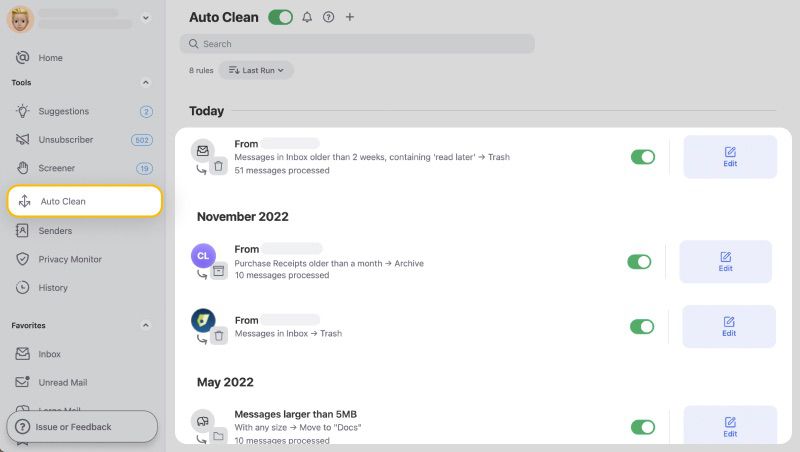
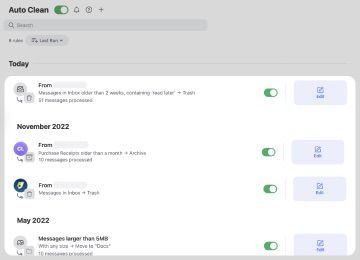
Another advantage of the app is its Action History feature, which records every filter applied, every email archived, deleted, or categorized, giving you full visibility and control over your email management processes.
Beyond traditional filtering, Clean Email offers other tools that enhance not only your email management but also your security, including but not limited to:
- Screener: captures emails from new senders and isolates them for your examination before they enter your main Inbox folder.

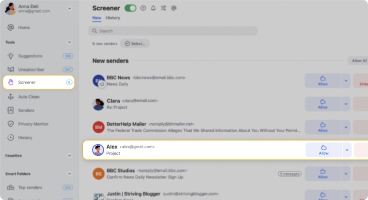
- Privacy Monitor: scours the internet for known data breaches and security incidents. If a breach has occurred, it will advise you to change the account password.
- Unsubscriber: makes it easy to minimize clutter in your inbox by unsubscribing from Outlook newsletters and marketing emails.

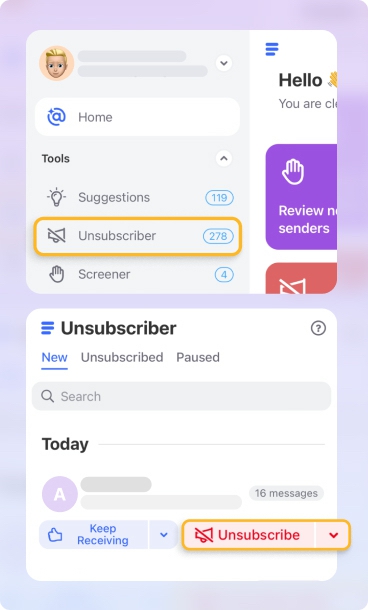
Just like Outlook itself, Clean Email is designed with security in mind and ensures your data is treated with the utmost confidentiality and integrity. So why not give this tool a try and see how it can help you take control of your inbox?
Related posts:
How to Filter Emails in Outlook - FAQs
How do I make emails go to a specific folder in Outlook?
To direct emails to a specific folder, create a rule in Outlook by selecting an email, clicking on “Rules” under the “Home” tab, and specifying your criteria. For enhanced functionality, consider integrating a tool like Clean Email, which offers more comprehensive filtering capabilities and more customizable automation.
How do I filter emails by category in Outlook?
First, assign categories to your emails by selecting them and clicking the "Categorize" button on the Home tab. Then, use the filter options to sort your inbox by these categories, making it easier to locate related emails.
How do I filter all emails in Outlook by importance?
Create rules to sort emails by importance by selecting a message, clicking on “Rules” under the “Home” tab, and specifying conditions such as sender or subject. This allows you to automatically categorize emails as high or low priority as they arrive.
What are the two types of Outlook rules?
It recognizes two types of rules:
- Server-based rules: When you create a server-based rule, the rule will be applied directly by the email server.
- Client-only rules: On the other hand, client-only rules are applied locally on your computer.
How do I filter unread emails in Outlook?
To filter unread emails in Outlook, use the "Unread" quick filter option available in the inbox view, which isolates all messages marked as unread. For more tailored filtering, consider using Clean Email's advanced sorting options to automate and simplify the process.
How can I filter emails by date in Outlook?
To filter emails by date in Outlook 2016 and later versions, including Outlook for Microsoft 365, click on the "Filter Email" button under the "Home" tab and choose your desired date range. You can also use the search bar, entering terms like “received: yesterday” to locate emails from specific days.
How do I filter emails with attachments in Outlook?
In Outlook 2016 and later versions, including Outlook for Microsoft 365, click on "Filter Email" in the "Home" tab and choose "Has Attachments". This will display all emails that contain attachments.


